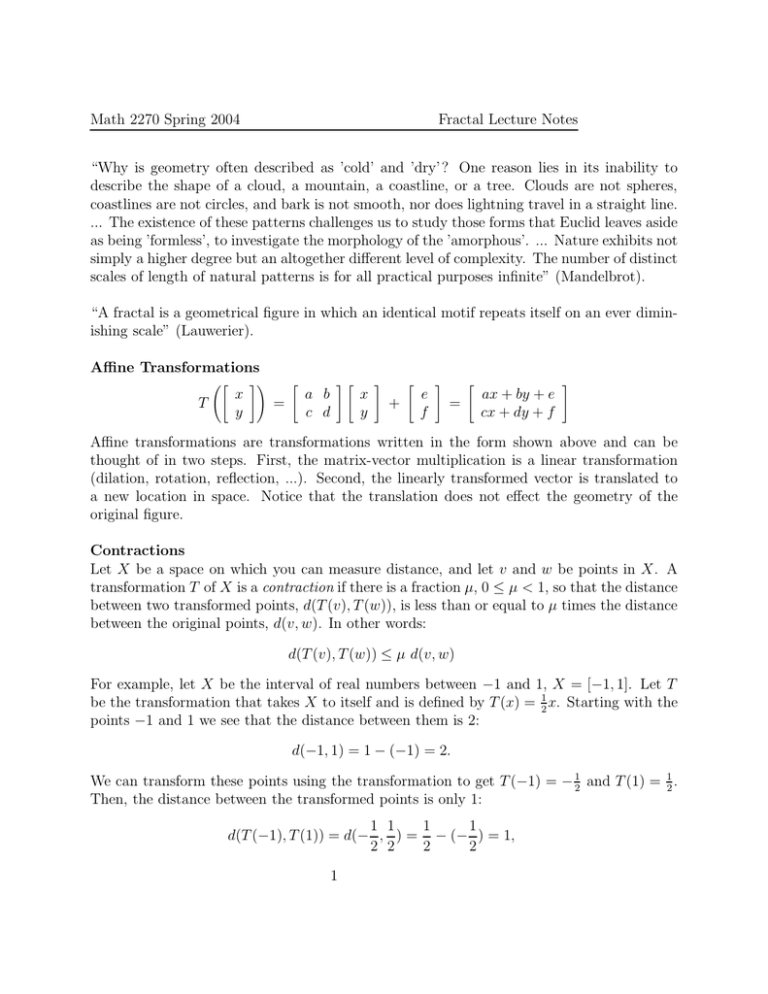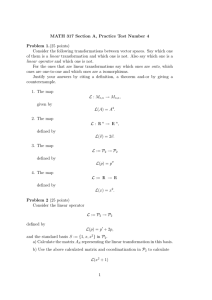Math 2270 Spring 2004 Fractal Lecture Notes
advertisement

Math 2270 Spring 2004 Fractal Lecture Notes “Why is geometry often described as ’cold’ and ’dry’ ? One reason lies in its inability to describe the shape of a cloud, a mountain, a coastline, or a tree. Clouds are not spheres, coastlines are not circles, and bark is not smooth, nor does lightning travel in a straight line. ... The existence of these patterns challenges us to study those forms that Euclid leaves aside as being ’formless’, to investigate the morphology of the ’amorphous’. ... Nature exhibits not simply a higher degree but an altogether different level of complexity. The number of distinct scales of length of natural patterns is for all practical purposes infinite” (Mandelbrot). “A fractal is a geometrical figure in which an identical motif repeats itself on an ever diminishing scale” (Lauwerier). Affine Transformations T " x y #! = " a b c d #" x y # + " e f # = " ax + by + e cx + dy + f # Affine transformations are transformations written in the form shown above and can be thought of in two steps. First, the matrix-vector multiplication is a linear transformation (dilation, rotation, reflection, ...). Second, the linearly transformed vector is translated to a new location in space. Notice that the translation does not effect the geometry of the original figure. Contractions Let X be a space on which you can measure distance, and let v and w be points in X. A transformation T of X is a contraction if there is a fraction µ, 0 ≤ µ < 1, so that the distance between two transformed points, d(T (v), T (w)), is less than or equal to µ times the distance between the original points, d(v, w). In other words: d(T (v), T (w)) ≤ µ d(v, w) For example, let X be the interval of real numbers between −1 and 1, X = [−1, 1]. Let T be the transformation that takes X to itself and is defined by T (x) = 21 x. Starting with the points −1 and 1 we see that the distance between them is 2: d(−1, 1) = 1 − (−1) = 2. We can transform these points using the transformation to get T (−1) = − 21 and T (1) = 12 . Then, the distance between the transformed points is only 1: 1 1 1 1 d(T (−1), T (1)) = d(− , ) = − (− ) = 1, 2 2 2 2 1 Math 2270 Spring 2004 Fractal Lecture Notes which is half of the original distance. In general, 1 v 1 1 1 d(T (v), T (w)) = − w = |v − w| = d(v, w) 2 2 2 2 Therefore, if we let µ = 12 , the transformation T satisfies the criteria and is a contraction. If we are working with a “nice” set of numbers (a complete metric space) and we iterate a contraction (that takes a set to itself) over and over again, we will eventually arrive at a fixed point (Banach Fixed Point Principle or Contraction Mapping Theorem). A fixed point is a point x in the space X such that T (x) = x. In other words, if we transform a fixed point using the transformation T , we get the fixed point back again. For example, using the contraction mapping from our previous example, T (x) = 12 x, we see that T (0) = 0 so the point x = 0 is a fixed point. One interesting property of contraction mappings in “nice” spaces is that if we start with a point anywhere in space and repeatedly take the transformation, we will get closer and closer to the unique fixed point. We can illustrate this with the transformation from above, T (x) = 12 starting at the point x = 1. 1 T (1) = → T 2 1 1 = →T 2 4 1 1 = →T 4 8 1 1 = →T 8 16 1 1 = 16 32 No matter what point we choose to start at, we will always get numbers closer and closer to zero as we perform repeated transformations. In general: x T (x) = → T 2 x x = →T 2 4 x x = →T 4 8 x x = →T 8 16 x x = 16 32 Hausdorff Distance One way to measure the distance between two sets (call them X and Y) is to define distance as the larger of the following two quantities: the maximum distance from all points in X to their nearest point in Y, and the maximum distance from all points in Y to their nearest point in X. This definition of distance (Hausdorff distance) allows us to measure the distance between two objects, for example between two squares. It turns out that if we have a “nice” space X (a complete metric space), and several contraction mappings that map the space X to itself (T1 , T2 , T3 , ..., Tn ), where distance is defined as the Hausdorff distance, then the combined effect of performing all of the mappings on the 2 Math 2270 Spring 2004 Fractal Lecture Notes same point to produce a set of points is also a contraction mapping. In addition, this joint contraction mapping has a unique fixed point (Hutchinson’s Theorem 1981). Let’s look at a simple example to illustrate this last point. Let X be the set of all real numbers in the interval [0, 1], and let T1 (x) = 12 x + 21 and T2 (x) = 14 x + 41 be contraction mappings that map X into itself. We can generate a series of points on the interval [0, 1] by starting with only the origin, x = 0. T1 (0) = T1 1 2 T2 (0) = 3 5 3 5 1 1 1 1 = = = = T1 T2 T2 2 4 4 8 2 8 4 16 3 7 11 13 3 5 5 T1 = = = = T1 T1 T1 4 8 8 16 8 16 16 7 11 13 3 3 5 5 T2 = = = = T2 T2 T2 4 16 8 32 8 32 16 1 4 21 32 21 64 If we repeat this process many, many times we will get closer and closer to the unique fixed point of the overall transformation (T1 ∪ T2 ). We can then plot the resulting points to get what we call a fractal. In this example, the picture will probably not be that interesting, but when we work with two dimensions, we can generate some amazing images. References Lauwerier, H. Fractals: Endlessly Repeated Geometrical Figures, Princeton University Press, New Jersey, 1991. Mandelbrot, B. The Fractal Geometry of Nature, Freeman and Co., New York, 1982. Peitgen, H., H. Jurgens and D. Saupe. Fractals for the Classroom: Part One, Introduction to Fractals and Chaos, Springer-Verlag, New York, 1992. 3

